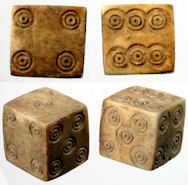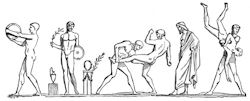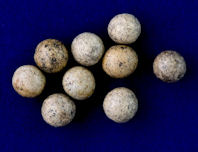Games People Played
Much as we’d like to think we humans have always had a major fun streak, I was surprised to find that we didn’t get our game on until many millennia after the ascent of man. It took our early gene pool nearly 200,000 years to figure out that life could be more than just kill or be killed, eat or be eaten.
The first real signs of human games appeared around 6,000 B. C. Stones and sticks were used in various forms of “play” to foretell the future or to chat with the gods. Rudimentary communities drew closer together to face the wrath or needs of their god(s), and the events foretold that might befall them.

Once we got the idea that the future might be predictable, gambling games weren’t far behind. According to Gambling Planet, dice-like stones and bones have been found that date back to 6,000 B. C. Greek gods played dice; early Indians played dice; and Egyptian hieroglyphs suggest rules and regulations for ancient dice games.
Native Americans, Aztecs, Mayas, Polynesians, Eskimos, and sub-Saharan Africans used plum stones, peach pits, pebbles, seeds, bones, deer horn, pottery, walnut shells, beaver teeth, and seashells to play dice games. (Gambling Origins)

“By 3000 B.C., early Chinese, European and Middle Eastern civilizations were gambling for fun and money.” (Gambling Planet)
Games were a part of everyday life in China by 1000 B.C. By 500 B. C. board games were common and civilizations around the world were regularly betting on fights and races between animals and between humans.
“The first Olympics, for example, were nothing more than a huge gambling enterprise” (Gambling Planet).

The Olympic games can be traced back to about 776 B. C. and continued on over 12 centuries. Although very different in many aspects from modern Olympics, the social/political goals of holding the games were about the same. Showcasing the superior strength, stamina, and skill of the youth of a particular place would certainly impress potential allies and enemies alike. The wins and losses in those early games most likely influenced who supported whom on what invasion campaign.
As a student of social networks, it appears that the earliest games helped to draw people together into rudimentary communities and to develop ties within and between those groups.
What about children’s games? According to the Kidipede website (among many others), ball games have been known for thousands of years. Marbles, hoops and sticks, tag, and running and jumping contests are very old children’s games.

Throwing balls and shooting marbles, running fast and jumping high were all survival skills one had to learn young and perfect quickly or be killed, captured, or eaten. Even hopscotch seems to have started out as a training exercise for the Roman Army.
When children compete with each other to learn survival skills is this really a game? Does every game we engage in teach us something we need to know to survive or thrive in the world at that time? This is an issue we’ll talk about more in our upcoming post on video games.

There is a whole body of research on “what is a game” and “what is play.” The crucial life lessons learned in children’s game play have been well documented in the field of psychology.
I’ll leave these aside for your investigation. My goal is to focus on games as social structuring activities that connect one person to another, forming simple connections into groups and networks. I am particularly interested in how social structuring appears to be changing as technology allows us to play complex games with others we never see or meet.

